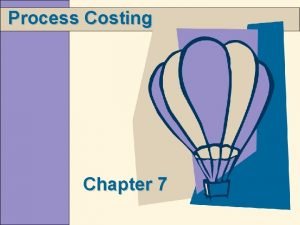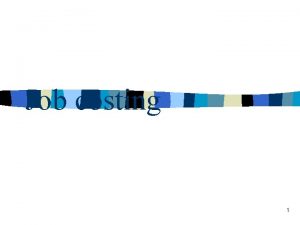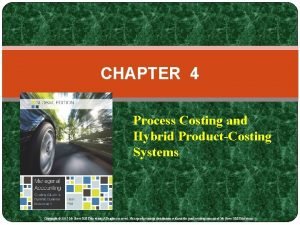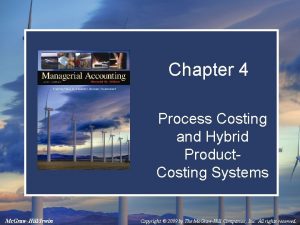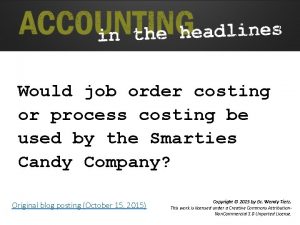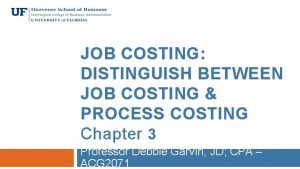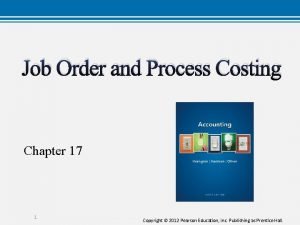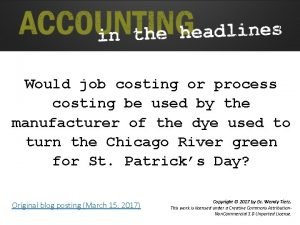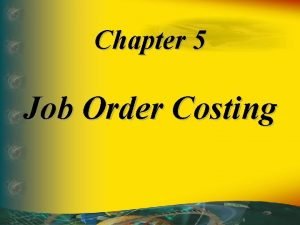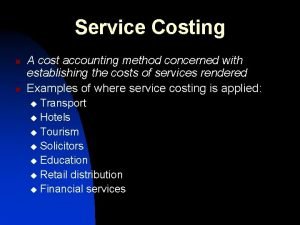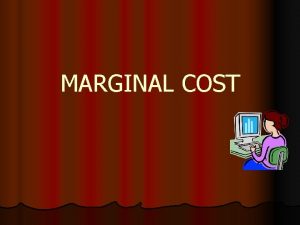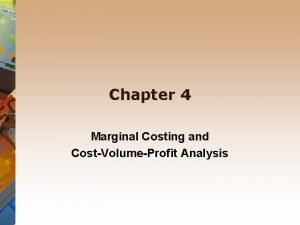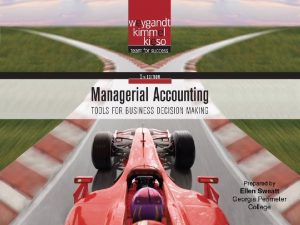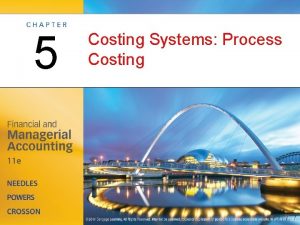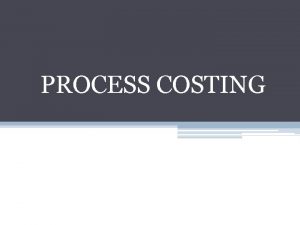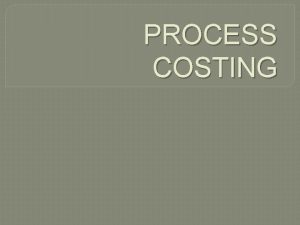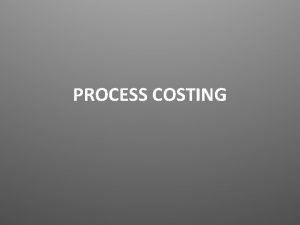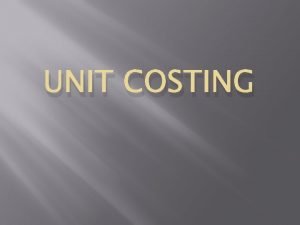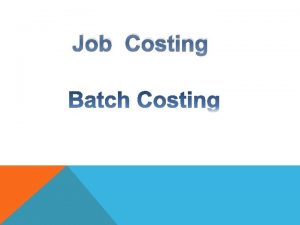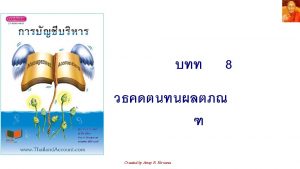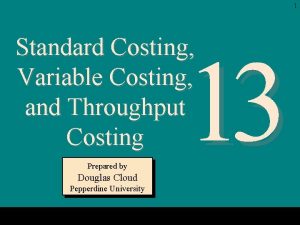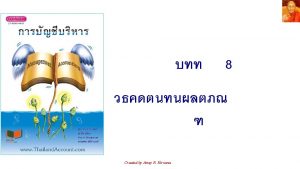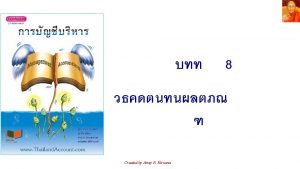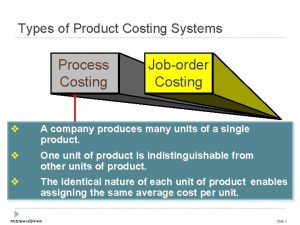Process Costing Process Costing Systems Process costing is

















- Slides: 17

Process Costing

Process Costing Systems • Process costing is a costing system in which the product or service cost is obtained by assigning costs to masses of like units • Conversion costs are costs that are applied uniformly in a department • Materials costs are assumed to be applied at discrete points in the production process • Transferred costs are costs transferred from one department to another department Pages 637 - 638

Process Costing System Diagram Material Costs Assembly Department Conversion Costs Transferred Costs Testing Department Finished Goods Inventory Conversion Costs Pages 637 - 638

Process Costing The cost accounting system used by a company depends upon the nature of its products or services. Process costing is more efficient for companies that produce large quantities of homogenous product in a continuous process.

Physical Flows for a Process Manufacturer Scrap Metal Materials Melting Department Casting Department

Physical Flows for a Process Manufacturer Molten metal transferred from Melting Department Casting Department To finished goods

Cost Flows for a Process Manufacturer Materials Purchases of D direct and M indirect materials Factory OH – Melting WIP – Casting D M Factory OH – Casting Finished Goods Cost of Goods Sold D M Direct materials used in production

Cost Flows for a Process Manufacturer Materials Purchases of D direct and M indirect materials Factory OH – Melting WIP – Melting D M D L Factory OH – Casting Actual costs incurred D L WIP – Casting Direct labor used in production Finished Goods Cost of Goods Sold

Cost Flows for a Process Manufacturer Materials Purchases of D direct and M indirect I materials M WIP – Melting D M D L Factory OH – Melting Factory OH – Casting Actual costs incurred I M WIP – Casting Finished Goods Cost of Goods Sold Indirect materials used in production

Cost Flows for a Process Manufacturer Materials Purchases of D direct and M indirect I materials M Factory OH – Melting Actual costs incurred FO A WIP – Melting WIP – Casting D M D L FO A Factory OH – Casting Actual costs incurred Factory overhead applied Finished Goods Cost of Goods Sold

Cost Flows for a Process Manufacturer Materials Purchases of D direct and M indirect I materials M Factory OH – Melting Actual costs incurred TO/T I FO A WIP – Melting D M D L FO A TO Factory OH – Casting Actual costs incurred WIP – Casting TI Finished Goods Cost of Goods Sold Cost transferred out/transferred in

Cost Flows for a Process Manufacturer Materials Purchases of D direct and M indirect I materials M Factory OH – Melting Actual costs incurred FO A WIP – Melting D M D L FO A TO Factory OH – Casting Actual costs incurred WIP – Casting TI D L FO A Finished Goods FO A D Direct labor used in production L FO Factory overhead applied A Cost of Goods Sold

Cost Flows for a Process Manufacturer Materials Purchases of D direct and M indirect I materials M Factory OH – Melting Actual costs incurred FO A WIP – Melting D M D L FO A TO Factory OH – Casting Actual costs incurred WIP – Casting TI D L FO A TO Finished Goods FO A TI Cost of Goods Sold TO/T Cost transferred out/transferred in I

Cost Flows for a Process Manufacturer Materials Purchases of D direct and M indirect I materials M Factory OH – Melting Actual costs incurred FO A WIP – Melting D M D L FO A TO Factory OH – Casting Actual costs incurred FO A WIP – Casting TI D L FO A Finished Goods TI Cost of goods sold COG S Cost of Goods Sold COG S TO

Cost Flows for a Process Manufacturer Materials Purchases of D direct and M indirect I materials M Factory OH – Melting Actual costs incurred FO A WIP – Melting D M D L FO A TO Factory OH – Casting Actual costs incurred FO A WIP – Casting TI D L FO A Finished Goods TI Cost of goods sold COG S Cost of Goods Sold COG S TO

Process Costing Steps • • 1. 2. 3. 4. 5. Equivalent units is a measure of the output of a process costing system 60 units 25% complete = 15 equivalent whole units Five Steps in Process Costing Track the physical units of output Determine the number of equivalent whole units Compute the cost per equivalent unit Measure total costs to account for Assign costs to units completed and transferred out of the department and units in ending inventory Pages 640 - 642

Weighted Average and FIFO Methods Weighted Average • Calculates the average equivalent unit cost of the work done to date regardless of when the work was done • Smoothes out unit costs from month to month FIFO • Costs carried forward from the previous period are assigned directly to completed goods • Assumes that work required to finish incomplete units (from the previous month) is done at the beginning of the month Pages 643 - 650
 Process costing and hybrid product-costing systems
Process costing and hybrid product-costing systems Wip control account
Wip control account Hybrid costing system example
Hybrid costing system example Product costing
Product costing Companies that use job order costing
Companies that use job order costing Job order cost and process cost systems
Job order cost and process cost systems Process costing definition
Process costing definition Distinguish between job costing and process costing
Distinguish between job costing and process costing Job costing with process costing
Job costing with process costing Example of process costing
Example of process costing Job costing vs process costing
Job costing vs process costing Job order cost accounting
Job order cost accounting Difference between service costing and output costing
Difference between service costing and output costing Absorption costing vs marginal costing
Absorption costing vs marginal costing Contract costing definition
Contract costing definition Variable costing vs absorption costing
Variable costing vs absorption costing Assumptions of cvp analysis
Assumptions of cvp analysis Advantages of activity based costing
Advantages of activity based costing
